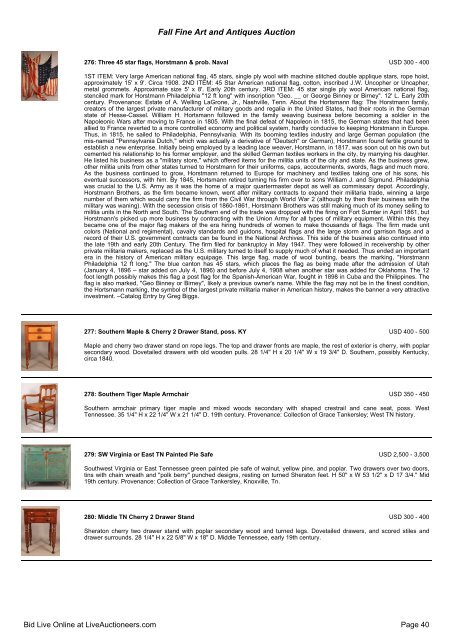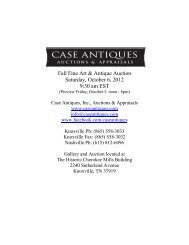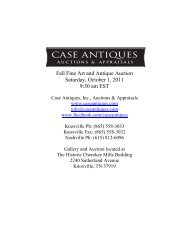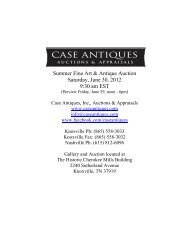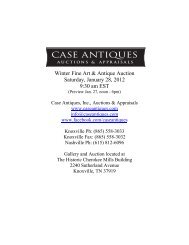Fall Fine Art and Antique Auction Saturday, October ... - Case Antiques
Fall Fine Art and Antique Auction Saturday, October ... - Case Antiques
Fall Fine Art and Antique Auction Saturday, October ... - Case Antiques
Create successful ePaper yourself
Turn your PDF publications into a flip-book with our unique Google optimized e-Paper software.
<strong>Fall</strong> <strong>Fine</strong> <strong>Art</strong> <strong>and</strong> <strong>Antique</strong>s <strong>Auction</strong>276: Three 45 star flags, Horstmann & prob. Naval USD 300 - 4001ST ITEM: Very large American national flag, 45 stars, single ply wool with machine stitched double applique stars, rope hoist,approximately 15' x 9'. Circa 1908. 2ND ITEM: 45 Star American national flag, cotton, inscribed J.W. Uncopher or Uncapher,metal grommets. Approximate size 5' x 8'. Early 20th century. 3RD ITEM: 45 star single ply wool American national flag,stenciled mark for Horstmann Philadelphia "12 ft long" with inscription "Geo. __ or George Binney or Birney". 12' L. Early 20thcentury. Provenance: Estate of A. Welling LaGrone, Jr., Nashville, Tenn. About the Hortsmann flag: The Horstmann family,creators of the largest private manufacturer of military goods <strong>and</strong> regalia in the United States, had their roots in the Germanstate of Hesse-Cassel. William H. Hortsmann followed in the family weaving business before becoming a soldier in theNapoleonic Wars after moving to France in 1805. With the final defeat of Napoleon in 1815, the German states that had beenallied to France reverted to a more controlled economy <strong>and</strong> political system, hardly conducive to keeping Horstmann in Europe.Thus, in 1815, he sailed to Philadelphia, Pennsylvania. With its booming textiles industry <strong>and</strong> large German population (themis-named "Pennsylvania Dutch," which was actually a derivative of "Deutsch" or German), Horstmann found fertile ground toestablish a new enterprise. Initially being employed by a leading lace weaver, Horstmann, in 1817, was soon out on his own butcemented his relationship to his former employer, <strong>and</strong> the skilled German textiles workers in the city, by marrying his daughter.He listed his business as a "military store," which offered items for the militia units of the city <strong>and</strong> state. As the business grew,other militia units from other states turned to Horstmann for their uniforms, caps, accouterments, swords, flags <strong>and</strong> much more.As the business continued to grow, Horstmann returned to Europe for machinery <strong>and</strong> textiles taking one of his sons, hiseventual successors, with him. By 1845, Hortsmann retired turning his firm over to sons William J. <strong>and</strong> Sigmund. Philadelphiawas crucial to the U.S. Army as it was the home of a major quartermaster depot as well as commissary depot. Accordingly,Horstmann Brothers, as the firm became known, went after military contracts to exp<strong>and</strong> their militaria trade, winning a largenumber of them which would carry the firm from the Civil War through World War 2 (although by then their business with themilitary was waning). With the secession crisis of 1860-1861, Horstmann Brothers was still making much of its money selling tomilitia units in the North <strong>and</strong> South. The Southern end of the trade was dropped with the firing on Fort Sumter in April 1861, butHorstmann's picked up more business by contracting with the Union Army for all types of military equipment. Within this theybecame one of the major flag makers of the era hiring hundreds of women to make thous<strong>and</strong>s of flags. The firm made unitcolors (National <strong>and</strong> regimental), cavalry st<strong>and</strong>ards <strong>and</strong> guidons, hospital flags <strong>and</strong> the large storm <strong>and</strong> garrison flags <strong>and</strong> arecord of their U.S. government contracts can be found in the National Archives. This side of the business also continued intothe late 19th <strong>and</strong> early 20th Century. The firm filed for bankruptcy in May 1947. They were followed in receivership by otherprivate militaria makers, replaced as the U.S. military turned to itself to supply much of what it needed. Thus ended an importantera in the history of American military equipage. This large flag, made of wool bunting, bears the marking, "HorstmannPhiladelphia 12 ft long." The blue canton has 45 stars, which places the flag as being made after the admission of Utah(January 4, 1896 – star added on July 4, 1896) <strong>and</strong> before July 4, 1908 when another star was added for Oklahoma. The 12foot length possibly makes this flag a post flag for the Spanish-American War, fought in 1898 in Cuba <strong>and</strong> the Philippines. Theflag is also marked, "Geo Binney or Birney", likely a previous owner's name. While the flag may not be in the finest condition,the Hortsmann marking, the symbol of the largest private militaria maker in American history, makes the banner a very attractiveinvestment. –Catalog Entry by Greg Biggs.277: Southern Maple & Cherry 2 Drawer St<strong>and</strong>, poss. KY USD 400 - 500Maple <strong>and</strong> cherry two drawer st<strong>and</strong> on rope legs. The top <strong>and</strong> drawer fronts are maple, the rest of exterior is cherry, with poplarsecondary wood. Dovetailed drawers with old wooden pulls. 28 1/4" H x 20 1/4" W x 19 3/4" D. Southern, possibly Kentucky,circa 1840.278: Southern Tiger Maple Armchair USD 350 - 450Southern armchair primary tiger maple <strong>and</strong> mixed woods secondary with shaped crestrail <strong>and</strong> cane seat, poss. WestTennessee. 35 1/4" H x 22 1/4" W x 21 1/4" D. 19th century. Provenance: Collection of Grace Tankersley; West TN history.279: SW Virginia or East TN Painted Pie Safe USD 2,500 - 3,500Southwest Virginia or East Tennessee green painted pie safe of walnut, yellow pine, <strong>and</strong> poplar. Two drawers over two doors,tins with chain wreath <strong>and</strong> "polk berry" punched designs, resting on turned Sheraton feet. H 50" x W 53 1/2" x D 17 3/4." Mid19th century. Provenance: Collection of Grace Tankersley, Knoxville, Tn.280: Middle TN Cherry 2 Drawer St<strong>and</strong> USD 300 - 400Sheraton cherry two drawer st<strong>and</strong> with poplar secondary wood <strong>and</strong> turned legs. Dovetailed drawers, <strong>and</strong> scored stiles <strong>and</strong>drawer surrounds. 28 1/4" H x 22 5/8" W x 18" D. Middle Tennessee, early 19th century.Bid Live Online at Live<strong>Auction</strong>eers.com Page 40


